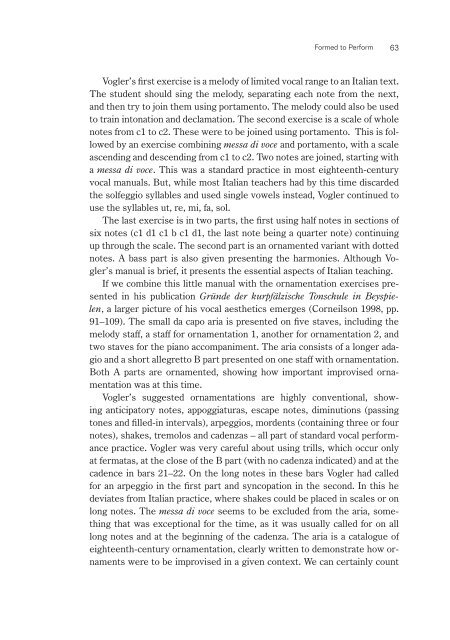Opera on the Move in the Nordic Countries during the Long 19th ...
Opera on the Move in the Nordic Countries during the Long 19th ...
Opera on the Move in the Nordic Countries during the Long 19th ...
You also want an ePaper? Increase the reach of your titles
YUMPU automatically turns print PDFs into web optimized ePapers that Google loves.
Formed to Perform<br />
Vogler’s first exercise is a melody of limited vocal range to an Italian text.<br />
The student should s<strong>in</strong>g <strong>the</strong> melody, separat<strong>in</strong>g each note from <strong>the</strong> next,<br />
and <strong>the</strong>n try to jo<strong>in</strong> <strong>the</strong>m us<strong>in</strong>g portamento. The melody could also be used<br />
to tra<strong>in</strong> <strong>in</strong>t<strong>on</strong>ati<strong>on</strong> and declamati<strong>on</strong>. The sec<strong>on</strong>d exercise is a scale of whole<br />
notes from c1 to c2. These were to be jo<strong>in</strong>ed us<strong>in</strong>g portamento. This is followed<br />
by an exercise comb<strong>in</strong><strong>in</strong>g messa di voce and portamento, with a scale<br />
ascend<strong>in</strong>g and descend<strong>in</strong>g from c1 to c2. Two notes are jo<strong>in</strong>ed, start<strong>in</strong>g with<br />
a messa di voce. This was a standard practice <strong>in</strong> most eighteenth-century<br />
vocal manuals. But, while most Italian teachers had by this time discarded<br />
<strong>the</strong> solfeggio syllables and used s<strong>in</strong>gle vowels <strong>in</strong>stead, Vogler c<strong>on</strong>t<strong>in</strong>ued to<br />
use <strong>the</strong> syllables ut, re, mi, fa, sol.<br />
The last exercise is <strong>in</strong> two parts, <strong>the</strong> first us<strong>in</strong>g half notes <strong>in</strong> secti<strong>on</strong>s of<br />
six notes (c1 d1 c1 b c1 d1, <strong>the</strong> last note be<strong>in</strong>g a quarter note) c<strong>on</strong>t<strong>in</strong>u<strong>in</strong>g<br />
up through <strong>the</strong> scale. The sec<strong>on</strong>d part is an ornamented variant with dotted<br />
notes. A bass part is also given present<strong>in</strong>g <strong>the</strong> harm<strong>on</strong>ies. Although Vogler’s<br />
manual is brief, it presents <strong>the</strong> essential aspects of Italian teach<strong>in</strong>g.<br />
If we comb<strong>in</strong>e this little manual with <strong>the</strong> ornamentati<strong>on</strong> exercises presented<br />
<strong>in</strong> his publicati<strong>on</strong> Gründe der kurpfälzische T<strong>on</strong>schule <strong>in</strong> Beyspielen,<br />
a larger picture of his vocal aes<strong>the</strong>tics emerges (Corneils<strong>on</strong> 1998, pp.<br />
91–109). The small da capo aria is presented <strong>on</strong> five staves, <strong>in</strong>clud<strong>in</strong>g <strong>the</strong><br />
melody staff, a staff for ornamentati<strong>on</strong> 1, ano<strong>the</strong>r for ornamentati<strong>on</strong> 2, and<br />
two staves for <strong>the</strong> piano accompaniment. The aria c<strong>on</strong>sists of a l<strong>on</strong>ger adagio<br />
and a short allegretto B part presented <strong>on</strong> <strong>on</strong>e staff with ornamentati<strong>on</strong>.<br />
Both A parts are ornamented, show<strong>in</strong>g how important improvised ornamentati<strong>on</strong><br />
was at this time.<br />
Vogler’s suggested ornamentati<strong>on</strong>s are highly c<strong>on</strong>venti<strong>on</strong>al, show<strong>in</strong>g<br />
anticipatory notes, appoggiaturas, escape notes, dim<strong>in</strong>uti<strong>on</strong>s (pass<strong>in</strong>g<br />
t<strong>on</strong>es and filled-<strong>in</strong> <strong>in</strong>tervals), arpeggios, mordents (c<strong>on</strong>ta<strong>in</strong><strong>in</strong>g three or four<br />
notes), shakes, tremolos and cadenzas – all part of standard vocal performance<br />
practice. Vogler was very careful about us<strong>in</strong>g trills, which occur <strong>on</strong>ly<br />
at fermatas, at <strong>the</strong> close of <strong>the</strong> B part (with no cadenza <strong>in</strong>dicated) and at <strong>the</strong><br />
cadence <strong>in</strong> bars 21–22. On <strong>the</strong> l<strong>on</strong>g notes <strong>in</strong> <strong>the</strong>se bars Vogler had called<br />
for an arpeggio <strong>in</strong> <strong>the</strong> first part and syncopati<strong>on</strong> <strong>in</strong> <strong>the</strong> sec<strong>on</strong>d. In this he<br />
deviates from Italian practice, where shakes could be placed <strong>in</strong> scales or <strong>on</strong><br />
l<strong>on</strong>g notes. The messa di voce seems to be excluded from <strong>the</strong> aria, someth<strong>in</strong>g<br />
that was excepti<strong>on</strong>al for <strong>the</strong> time, as it was usually called for <strong>on</strong> all<br />
l<strong>on</strong>g notes and at <strong>the</strong> beg<strong>in</strong>n<strong>in</strong>g of <strong>the</strong> cadenza. The aria is a catalogue of<br />
eighteenth-century ornamentati<strong>on</strong>, clearly written to dem<strong>on</strong>strate how ornaments<br />
were to be improvised <strong>in</strong> a given c<strong>on</strong>text. We can certa<strong>in</strong>ly count<br />
63
















